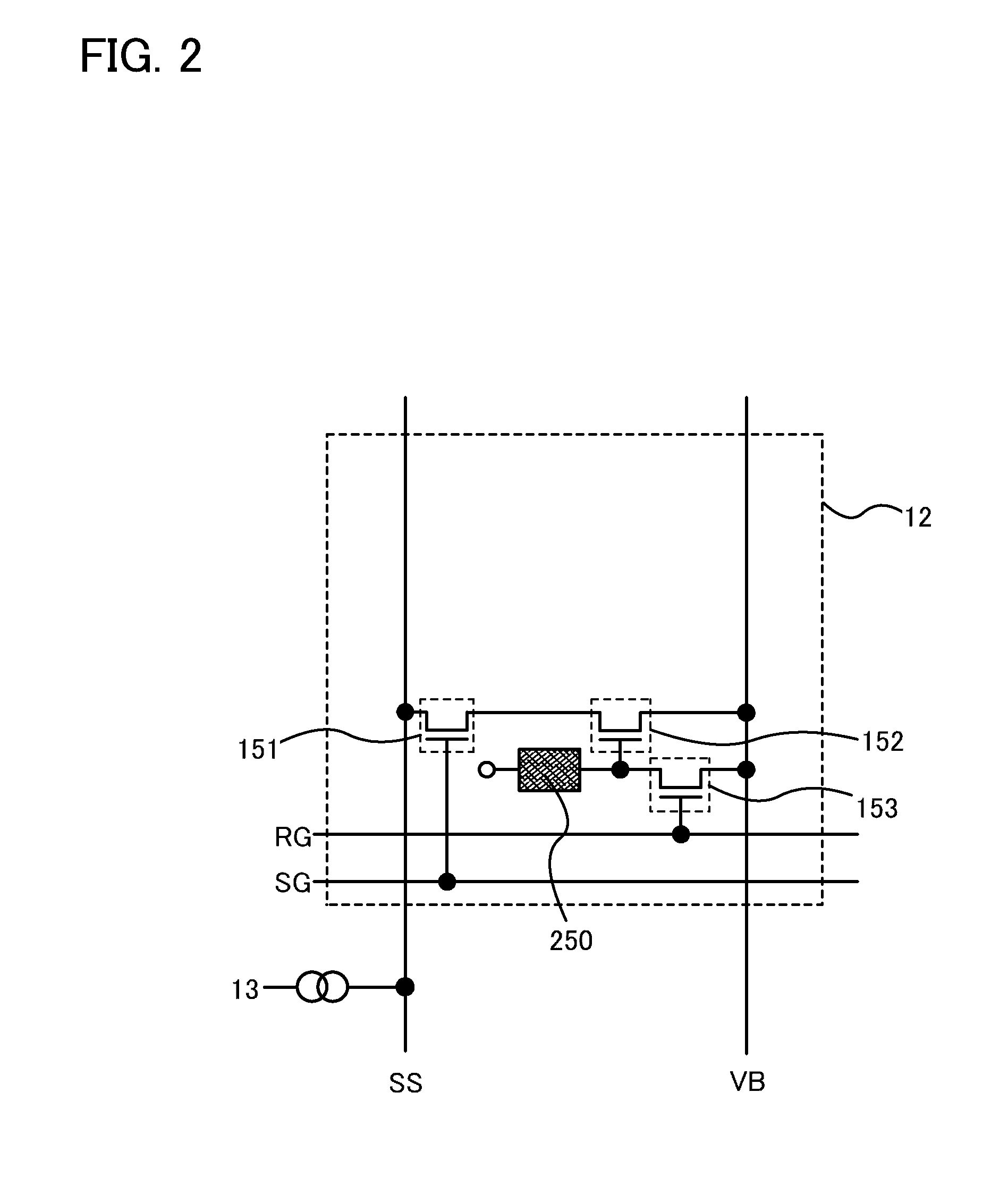Photosensor and display device
a technology of display device and photosensor, which is applied in the field of photosensors, can solve the problems of low mobility of amorphous silicon thin film, high cost and impracticality of the size of an area sensor is limited by the size of a single crystal silicon substrate, so as to achieve low cost and impracticality, and the effect of high writing speed
- Summary
- Abstract
- Description
- Claims
- Application Information
AI Technical Summary
Benefits of technology
Problems solved by technology
Method used
Image
Examples
embodiment 1
[0051]In this embodiment, an example of an area sensor including a plurality of photoelectric conversion elements and amplifier circuits is described with reference to drawings. The amplifier circuit includes thin film transistors including an oxide semiconductor, particularly, an oxide semiconductor containing indium, gallium, and zinc.
[0052]FIG. 1 illustrates connections of reset gate signal lines RG1 to RGy, sensor gate signal lines SG1 to SGy, sensor output wirings SS1 to SSx, a sensor power supply line VB, and a plurality of pixels 12 which are included in an area sensor portion 11.
[0053]In the area sensor portion 11, the plurality of pixels 12 are arranged in a matrix. Each of the pixels 12 is connected to one of the reset gate signal lines RG1 to RGy, one of the sensor gate signal lines SG1 to SGy, one of the sensor output wirings SS1 to SSx, and the sensor power supply line VB.
[0054]The sensor output wirings SS1 to SSx are connected to constant current power supplies 13_1 to...
embodiment 2
[0095]In this embodiment, an example of a manufacturing process for the area sensor in FIG. 4 which is described in Embodiment 1 is described with reference to FIGS. 5A to 5D and FIGS. 6A to 6D. Note that since main parts of the selection TFT 151, the amplifying TFT 152, and the reset TFT 153, the manufacturing process of which is described with reference to FIGS. 5A to 5D and FIGS. 6A to 6D, have the same structure, a process for forming the selection TFT 151 is mainly described below.
[0096]In FIG. 5A, a light-transmitting substrate is used as a substrate 100. A glass substrate of barium borosilicate glass, aluminoborosilicate glass, aluminosilicate glass, or the like available in the market can be employed. For example, a glass substrate which includes more barium oxide (BaO) than boric acid (B2O3) in composition ratio and whose strain point is 730° C. or higher is preferable. This is because such a glass substrate is not strained even when an oxide semiconductor layer is thermall...
embodiment 3
[0149]In this embodiment, a manufacturing process for an embodiment of an area sensor which is different from that of Embodiment 2 is described with reference to FIGS. 7A to 7D. In this embodiment, light directly reaches an area sensor which is formed over a substrate.
[0150]By the method described in Embodiment 2, an amplifier circuit which includes a thin film transistor including an oxide semiconductor containing indium, gallium, and zinc, the first interlayer insulating film 109, and the second interlayer insulating film 121 are formed over the substrate using four photomasks. FIG. 7A shows a cross-sectional view at this step. Note that if a structure in which light directly reaches the area sensor formed over the substrate is employed, the substrate 100, the gate insulating film 102, the first interlayer insulating film 109, and the second interlayer insulating film 121 are not always required to have a light-transmitting property. Further, the second interlayer insulating film ...
PUM
| Property | Measurement | Unit |
|---|---|---|
| temperature | aaaaa | aaaaa |
| temperature | aaaaa | aaaaa |
| electrical conductivity | aaaaa | aaaaa |
Abstract
Description
Claims
Application Information
 Login to View More
Login to View More - R&D
- Intellectual Property
- Life Sciences
- Materials
- Tech Scout
- Unparalleled Data Quality
- Higher Quality Content
- 60% Fewer Hallucinations
Browse by: Latest US Patents, China's latest patents, Technical Efficacy Thesaurus, Application Domain, Technology Topic, Popular Technical Reports.
© 2025 PatSnap. All rights reserved.Legal|Privacy policy|Modern Slavery Act Transparency Statement|Sitemap|About US| Contact US: help@patsnap.com



